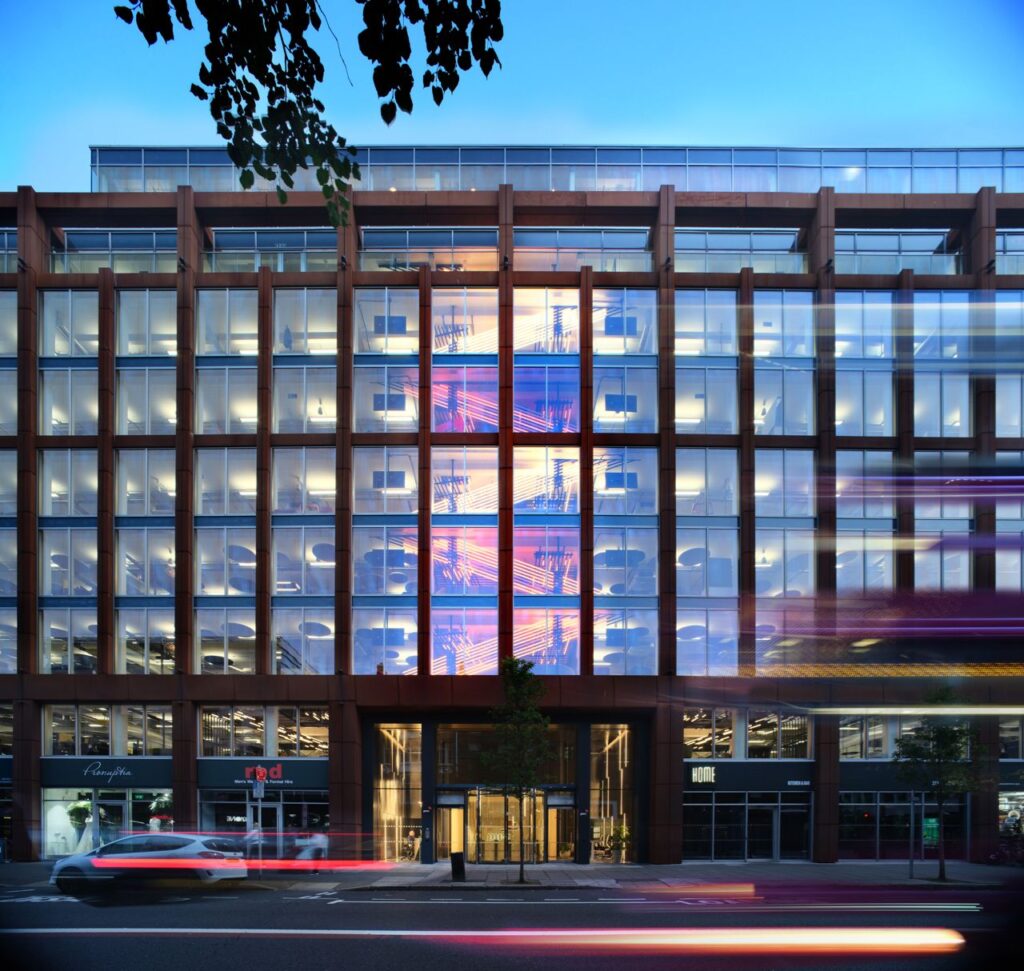

21 September, Guildhall, London
Last week, members and guests got together at the 2022 President’s Lunch at the Guildhall in London.
In his speech, BCO President Mark Kowal said: “The office of the future will undoubtedly be different – it will continue to evolve, embracing hybrid working, social consciousness, healthy living and environmental responsiveness – and we should be instrumental in this change. The office investment and leasing markets witnessed a robust bounce-back after the pandemic with the UK as the strongest performer in Europe during the 12 months, leading up to the second quarter of this year. More companies across the UK were expanding rather than contracting.”
Optimistic that the BCO community is well positioned to bounce back and stand ready to lead the response to recovery, Mark reminded us: “The theme at this year’s sell-out BCO Conference in Manchester was ‘our time is now’. This is applicable to many aspects of the office: – it is time to change how we work to create a healthier environment and a healthier way of life; it is time for the office sector to play its part in the climate agenda and strive for Net Zero Carbon; it is time for landlords, developers and investors to work more closely with occupiers to achieve all these goals; and it is also time for the BCO to be more bold and be seen to lead and guide our members in pursuit of delivering on these aspirations.”
Financial Times Economics Editor Chris Giles was typically insightful about our economic prospects. While we are almost certainly going to go into recession, however, compared to previous years we understand it more and can manage it. Expect challenges over the Winter, but our cities and their offices have proved resilient time and time again.
Chris concluded that “The recession we are likely to have need not be deep. It may not be very long. And I expect that the Western Economy will get through this.”
Until next time, thank you to everyone who attended. Look out for more photos from the President’s Lunch on Flickr (coming soon).
Follow Mark Kowal, Partner @ Sheppard Robson on LinkedIn.
.png)

By Kat Adair, Associate, Ridge & Partners LLP, BCO NextGen London
Placing employee wellbeing at the heart of ESG agendas is becoming a necessity for companies big or small. And it shouldn’t be a difficult decision to make when considering that the benefits of doing so far outweigh the costs – not only for employees but for companies as well.
The commercial benefits of investing in wellbeing and healthy buildings are increasingly recognised, especially by those companies in the middle to top end of the office market. It’s become clear to them that being proactive about employee wellbeing can help to avoid future costly redesigns, reduce operational costs, and increase productivity and talent retention. In this sense, the benefits of investing in employee wellbeing are becoming much more quantifiable and as such more attractive for decision makers in most sectors.
Now for those with restricted budgets, who are perhaps thinking ‘this is all well and good, but how much is this going to cost us?’. Well, ‘not as much as you might think’ is the simple answer. There are a lot of misconceptions out there about workplace wellbeing, and more generally ESG, being complex and expensive. Although this can be true for those large-scale projects, there are many simple and cost-effective changes that can make a huge difference.
It’s important to remember that not all organisations have the same budget, and in order for wellbeing to become commonplace in our ESG agenda, it must be inclusive.
In my view, a lot of the positive changes we’ve seen in modern workplaces already contribute to employee wellbeing and ESG agendas, even if they are not labelled as such. In a recent research paper on Designing and Managing Buildings for Health and Wellbeing, experts from the British Council for Offices pointed out that ‘small’ changes such as improving office air quality, lighting, acoustics and biophilia are all impactful initiatives.
A healthy building can also be achieved through easy steps such as having well-thought-out FM policies. For example, another recent report from the BCO, on improved ventilation systems in offices post-COVID, suggested that allowing employees to open windows is a more economical and sustainable way to provide them with fresh air than investing in costly ventilation and air monitoring systems. Similarly, well-planned HR strategies around flexible working solutions can have an important impact on employee wellbeing, while only requiring minimal changes around the office.
Of course, for the more complex policies and processes and more drastic changes to your office space, it does appear that having Sustainability or CSR directors leading on large-scale wellbeing programmes is still the most promising path to success. However, this might not be the right approach for all businesses, depending on where they are on their ESG journey.
Leading with the implementation of lower cost facilities management and policy initiatives can reduce capital expenditure, whilst still providing good outcomes for building users, which is a great start.


Cian Scanlon, Associate Architect at PDP London Architects, puts forth his idea for the future workplace in the form of ‘The Disconnected Office’. His experience in the architecture sector is on a global scale, encompassing Amsterdam, Hong Kong and Dublin to name a few. In 2018, he was shortlisted for the RIBAJ’s Rising Stars Award. Cian’s vision proposes a workplace that values physical interaction over digital connection and advocates for decreasing the pace of digital communication as a means to increase productivity, satisfaction and wellbeing.
The Disconnected Office
In the hybrid working age, digital ‘noise’ has become inescapable. The Disconnected Office offers an alternative — a digitally disconnected network of people brought together in a tailor-made physical environment. With hybrid working on the rise, the Disconnected Office provides a fundamentally different experience to working remotely encouraging staff to return to the workplace.
In 1930 John Maynard Keynes predicted that technological advances would enable us to work a 15-hour week. Unfortunately, that’s not the case for most of us. At some point technology outran our ability to absorb it into our working patterns in a productive and healthy way. We spend an increasing amount of time clearing an increasing number of emails and notifications. We commute to the office to connect with colleagues working remotely. The immediacy demanded by apps for digital connection leave us little time for reflection, arguably impede our effective thinking, and sustained over long periods may negatively affect our mental health. The Disconnected Office aims to address these shortcomings by creating dedicated areas where staff can connect digitally, as an exception rather than the rule. This reduces invasive technological stimuli so staff can focus, minimise reactive work and reduce anxiety.
The Disconnected Office is ‘pro-technology’. At the core of the idea is the selective and controlled use of technology to maximise productivity while optimising employee experience and wellbeing.
Part of removing the distraction of the digital network is to place the emphasis back on real-life connection. The lack of distraction will encourage and inspire staff to engage with each other and the wider community.
Written By Eilidh Tuckett.
Attend the BCO Ideas Project Final Showcase Evening on 29 September where the selected finalists will be sharing their 10-minute TED Talk style pitches. Visit bco.org.uk to book.


In his idea for ‘The People’s Workplace’ Andreas Leonidou, Consultant Cost Manager at Turner & Townsend, brings his range of experience in both the residential and commercial market sectors to the table. As a quantity surveyor, Andreas has worked alongside several major high street retail brands and organisations, as well as corporate business-to-business clients and residential developers. This first hand experience means he is well positioned to imagine a better future for the workplace.
The People’s Workplace
Magic Johnson, former owner of Starbucks and Burger King, once said: ’if the community is happy, then they support your business, and if your business is doing well, then you can give back even more to the community.’ This concept underpins the idea for The People’s Workplace — a genuinely hybridised working environment which brings community together in a productive, collaborative space.
Positive social impact is the driving force behind The People’s Workplace. It aims to address the inequalities between communities, which are based on the strength of community infrastructures, from design inception.
The current amount of underutilised UK office space, when applying the BCO’s recommendation of 89-108 square feet of space per person, would allow for between 530,000 – 650,000 people associated with local communities and educational organisations to be supported. By evolving these underutilised spaces into hybrid commercial community workplaces, we can drive positive change, bringing communities together. Crucially, this also avoids unnecessary construction, which is a step in the right direction towards addressing the climate emergency.
The People’s Workplace would incorporate spaces for both commercial businesses and local community and learning organisations, such as lecture theatres, seminar classrooms, exhibition halls and local charities. This closer working proximity would create a more fluid exchange between sectors, making it easier for organisations to achieve genuinely positive social impact.
Local charities could set up opportunities for their neighbouring employers to support events or fundraising activities, which would in turn assist the surrounding businesses in achieving their social impact goals. From an education standpoint, professionals from neighbouring businesses could offer relevant career advice, lectures and workshops.
Business professionals would be able to engage with charities and educational organisations, which would in turn create a strong sense of support from the commercial sector. New Technologies such as virtual collaboration tools could also be incorporated, further solidifying the sense of community.
Instead of a purely commercial-focused workspace, this widened working environment would break down the barriers between business, charity and education — creating genuine community. The People’s Workspace aims to transform the future of the workplace, for the benefit of everyone.
Written By Eilidh Tuckett.
Attend the BCO Ideas Project Final Showcase Evening on 29 September where the selected finalists will be sharing their 10-minute TED Talk style pitches. Visit bco.org.uk to book.


In his design for the ideal future workplace, Carl Heintz brings together his wealth of experience to offer something different. His background in architecture, business management, and running a company gives him a unique insight into how an effective office operates. Carl’s proposal for the BCO Ideas Project, ’Flexi-Space,’ aims to achieve what its title suggests — creating a modern work environment with an emphasis on positive social impact.
Flexi-Space
Sustainability should be a guiding force for any modern construction, and genuine impact starts by addressing the issue of occupancy. Current data collected by Freespace Index suggests that the average office occupancy for a week in central London now sits at just 31% — half of pre-pandemic figures. This seems at odds with the exorbitant price tag associated with renting those same office and events spaces, leaving the gate wide open to alternatives. Flexi-Space proposes a viable solution: introducing part time rents and transforming offices into spaces that can house several tenants within a day, with space for evening and weekend functions. As a practical example an established company could rent Tuesday-Thursday while a startup could rent Monday and Friday while the evenings and weekends would be full of leisure events and activities.
Flexi-Space explores pre-existing potential, avoiding ‘asset waste’ and benefitting companies that effectively use a pay-as-you-go system for office rental. Technology has enabled easy and efficient remote booking, which Flexi-Space will make use of. Companies will be able to rent as many days a week in an office as they want to, simply by using an app. Smart key cards, tables and lockers will be similarly accessible, creating a seamless process. Office equipment will also be shared, ensuring ready availability and quick setup for all inhabitants.
Four blocks of time will be available to rent daily, ranging from early morning until late evening, and will include desk zones and meeting rooms. Each company will be billed weekly, according to their reservations.
The pandemic paved the way for alternative work patterns, bringing a new wave of flexibility to the workplace. While most of these changes have been positive and long overdue, the sense of company culture that many businesses rely on has arguably suffered. This in turn affects the social experience of employees, who miss out on daily in-person collaboration. Increasing building occupancy, as Flexi-Space aims to, will create the potential for more connection between people, which we know to have a positive impact on mental health.
In short, Flexi-Space adapts to the needs of its tenants, addressing the issue of under-occupation and encouraging more leisure activities, that uses the power of technology to automate away the admin work of such a system.
Written By Eilidh Tuckett.
Attend the BCO Ideas Project Final Showcase Evening on 29 September where the selected finalists will be sharing their 10-minute TED Talk style pitches. Visit bco.org.uk to book.


Through her role in Workplace Experience & Strategy Consultation, Toni McCall helps clients create a stronger working culture, both in the office and working from home. Combined with her interior design experience, she is well equipped to turn her hand to designing the future workplace.
Common Grounds
‘Common Grounds’ (CG) is a concept created by Vela Interiors that encourages a shift towards transparency between employers and prospective employees. As a website and app-based service, CG provides a platform that pushes companies to compete to create the most supportive, sustainable, and charitable environment for its staff.
CG is more than your standard company review site. The software allows users to hone in on their personal priorities and apply them as a filter to identify companies with specific goals and values which align with their own, before applying for a job.
This purpose-led vision encourages employers to be more vocal and visible when taking a stance on social issues, and really practice what they preach. These concerns will shape operations and talent programmes, putting the employee at the centre and increasing the depth and transparency of reporting on purpose driven outcomes. At its core, CG will help drive effective change in the workforce, the ripple effect of which creates a positive outcome for all.
Organisations will have to communicate real, tangible progress on the CG website, providing ‘behind the scenes’ evidence of their actions towards progressing their stipulated purpose. This may take the form of reports backed up by accurate data from the organisation, event photographs that are updated regularly, or reviews from previous and current staff members. This pool of information will be accessible to prospective applicants, who are then able to make a fully informed decision on whether the company is right for them.
CG will use an algorithm to award a scoring system based on how regularly each company provides updates. Users can then easily ascertain the level of action a prospective employer takes against, eg, climate change or charitable engagements, without having to simply take their word for it.
CG’s ultimate goal is to facilitate the shift towards a more sustainable workforce, which balances the power between employer and employee, creating a more secure, supportive and productive environment for all.
Written By Eilidh Tuckett.
Attend the BCO Ideas Project Final Showcase Evening on 29 September where the selected finalists will be sharing their 10-minute TED Talk style pitches. Visit bco.org.uk to book.
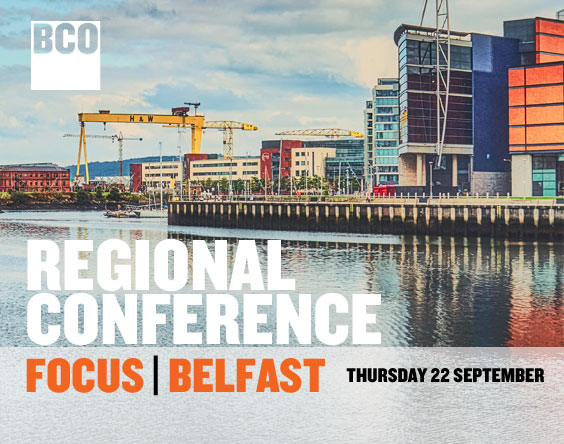
Less than two months until the BCO One Day Conference in Belfast
What to expect?
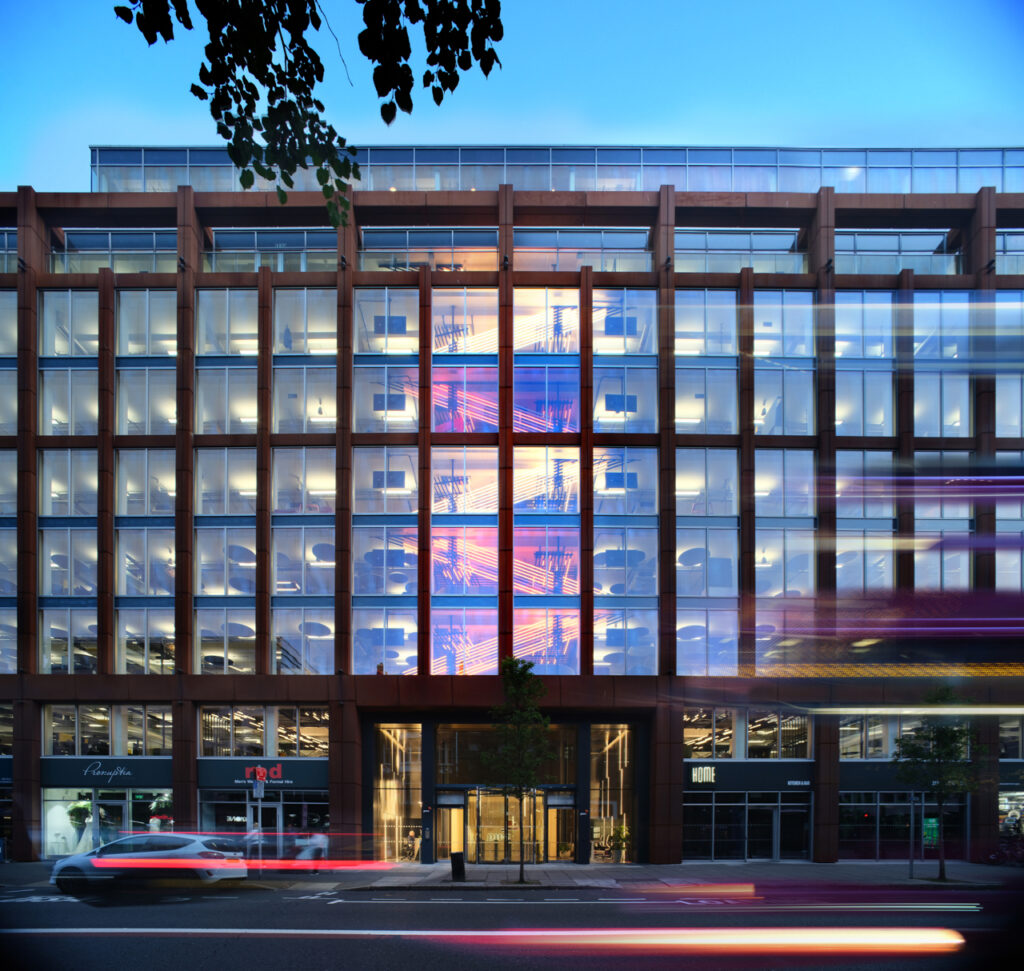

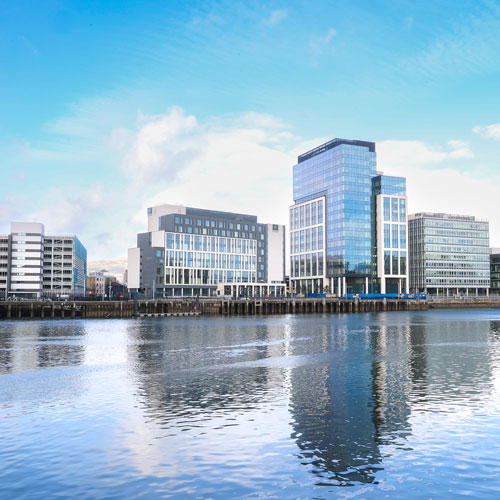
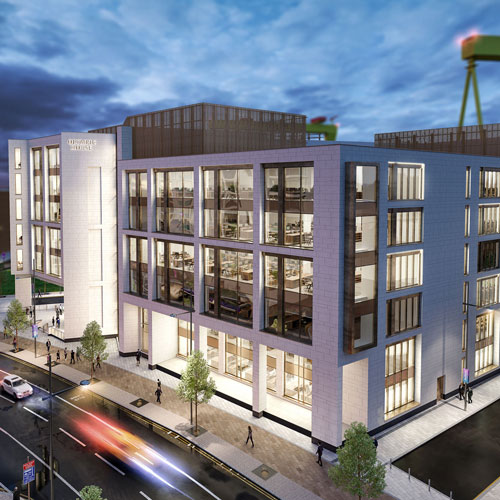

.png)
By Matthew Redgrove, BCO NextGen London
Building accreditations create a universal language for best practice within the construction industry, providing a road map for conscious design which centres around the ESG agenda. With the climate crisis looming ever larger and central government not currently enforcing new design standards, building accreditations are filling the gap by making our industry more sustainable.
Historically considered burdensome, sustainability concerns were passed around with the handover marking a final shift in responsibility from developer to contractor to occupier. The emerging suite of building accreditations means this will no longer be the case, and the industry is adapting accordingly. It is an exciting, challenging time in construction — as an industry we will have to pull together in an unprecedented way to deliver targets which are increasingly vital to the wellbeing of people and the planet.
New entrants to the market from across the globe are driving innovation across the industry
There are a host of new building accreditations on the market, brought in from across the globe. The American contingent includes WELL, FitWel, Wired Score, Smart Score and LEED, while Australia has brought NABERS to the table. Each encourages innovative solutions from developers, which push the market forward in specific ways.
These accreditations focus on a range of sustainability criteria thereby encouraging innovation. Indeed, using all available accreditations as a guide, developers are being prompted to consider the wider scope of their potential impact. This broad scope is motivating a more holistic approach to construction which places the emphasis on longevity and drives an end-to-end approach.
As designers and clients are getting to grips with these new accreditations, conflicts are beginning to emerge. These raise questions and spark creative solutions. For example, if smart technology is introduced on a project, how will it impact operational energy and carbon? If openable windows are installed – which have been shown to improve employee wellbeing, how will that balance with the additional embodied carbon required for the opening mechanism? While it is clear that these accreditations are beneficial from an ESG perspective, the challenge is figuring out how best to optimise their potential.
Together, this roster of new accreditations is changing the conversation around sustainability, and ultimately raising the bar across the industry.
The main driver in creating a culture of accountability in construction is the emergence of data transparent accreditations. This will encourage cross-industry collaboration towards a common end goal — building sustainably.
These accreditations mainly use three forms of scoring mechanisms: checklist, design consultation, and data driven – or a combination of the three.
BREEAM remains the industry benchmark because it is enforced through the planning process, but ultimately it is data-focused accreditations, such as NABERS, that are driving a complete overhaul in terms of how the industry regards building accreditations. The formerly dominant checklist approach, which ends at the point of handover, is no longer enough. Clients expect a more thorough consideration of green building practices, which extend throughout a building’s lifecycle.
BREEAM is still the bottom line, but by incorporating a cross-section of new accreditations, designers and developers can create more comprehensive outcomes. Capitalising on the availability of data that accreditations provide enables developers to produce buildings that continuously adapt to and deliver on sustainability goals.
It is clear that data driven accreditations provide a much more transparent, and therefore influential, overview of operational impact — which is ultimately what matters. Only when we capture and monitor this data are we going to be able to drive tangible improvement as an industry.
Accountability from end to end is what clients now expect, prompting an industry-wide paradigm shift towards a more holistic approach, which fits the ESG agenda.
With data-driven accreditations such as NABERS, ratings can only be achieved when meter readings are taken a year after occupancy. This kind of transparency completely shifts the goalposts, widening the scope for continual improvement which involves everyone and lasts long after handover.
Hard data offers a much clearer insight into the true sustainability credentials of a building by continuous monitoring over its operational lifetime. This is assessed year on year, which means there is no longer a clear division of responsibility. Designers and developers need to create something which is truly efficient; contractors need to deliver on that; and occupiers and asset managers have to maintain and improve on operational performance throughout the duration of the building’s life.
The availability of data will also directly affect asset value, market recognition and market reputation, which will be an incredibly powerful catalyst for change from a business perspective. Transparency of data effectively means that there is nowhere to hide — which will ultimately define the next phase of accountability in pursuit of genuine green buildings.
Moving forwards, there is — rightfully — a sense of constant monitoring which is a direct result of accreditation related data collection. No one will be exempt from this, because green buildings can’t exist without conscious investment and improvement at every stage, from every angle. The pursuit of sustainability is a constant process of improving operational performance to optimise a building over its lifetime, and data transparency means that everyone has to deliver because the facts are laid bare. This visibility holds people and businesses to account, and in turn, that accountability will raise the bar across the industry — ultimately shifting the market. Everyone will become more involved: investors, developers, clients, contractors and occupiers, end to end.
End-to-end requires a collaborative approach to building accreditations
Alongside changes in accreditations’ measurement, there is also a stronger focus on the full lifecycle of a project. Historically, assessment mechanisms have been static but the industry is beginning to adapt to working in a way where accreditations are a constant presence. This requires a collaborative approach — as the drive towards building sustainably gathers momentum, developers, contractors and occupiers will increasingly need to work together across the full lifecycle of a project.
Because accreditations are now end-to-end, it is no longer acceptable for developers to tick a box and move on, effectively terminating responsibility at the point of handover. Increasingly, a culture of early contractor involvement is arising which extends from consultancy through to occupation, and there is a significant change in how we approach the aftercare of assets. Clear-cut transfer of responsibilities are ceasing to exist. To maintain a presence and enact a force for change through handover requires an industry-wide overhaul from the design phase through to contractor and asset manager involvement.
While sustainable building design is already a priority, there is as yet no requirement to enforce sustainable practices past the point of handover. It’s not clear if this will need to be realised on a contractual basis or whether the market will shift more naturally towards green practices — thereby fulfilling client expectations organically. Arranging Green Leases with tenants is a potential avenue towards creating more sustainable buildings, i.e., explaining how occupiers should use the building in order to minimise operational energy as part of the lease agreement. It is also entirely possible that as people become more aware of the climate crisis, tenants will use buildings in a more consciously green way, thereby negating the need for a contract that stipulates the terms of use. It remains to be seen but will have to be monitored and assessed continuously.
The culture of accountability and collaborative approach created by the new wave of building accreditations is what will deliver lasting change in the industry. The incremental, intentional, collaborative progress they engender will ultimately drive the industry towards a more sustainable future.
With greater accountability and a more end-to-end approach, we’re on the right path as an industry
There is a question mark over how best to proceed in terms of building efficiently for the longer term, and as of yet we don’t have all the answers. What matters is that by using the many accreditations available as a road map, we are on the right path as an industry — intentionally making the design and operation of our buildings more productive, green and inclusive, consciously building a better future.

Click here to view upcoming panel discussions and BCO Events.
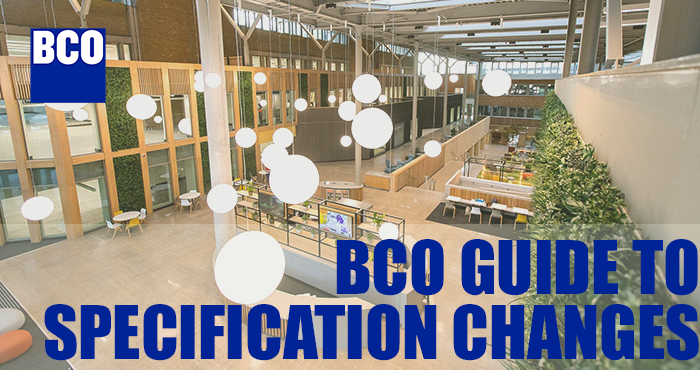
Deadline 29 July: a final reminder to have your say.
British Council for Offices proposes changes to Guide to Specification key design criteria to reflect recent unprecedented external influences and lower occupancy rates
The British Council for Offices (BCO) has released a position paper proposing updated key design criteria, as part of its most recognised publication, the BCO Guide to Specification.
We are asking our members to join the discussion by providing their comments and feedback on the criteria proposed in the position paper so that we can consider any fine-tuning required before we incorporate the new criteria into the digital version of the guide.
The guide, which is normally published every 4 or 5 years, provides expert best practice advice on how to specify office space, helping industry practitioners provide space that meets the needs of occupiers, helping them to conduct their business in safe, healthy, comfortable, and productive workspaces.
This selective update comes ahead of schedule and is in response to significant changes to the office sector since its last publication in 2019, with the pandemic drastically transforming the way in which we work and use the office.
The intention of this update to the BCO Guide Key Criteria is to reflect changes in design thinking over the last three years, taking in the climate crisis, the drive towards net zero carbon (NZC), COVID-19, moves to hybrid working, changes in occupational density, changes in regulations, and improvements in equipment performance.
A copy of the paper can be downloaded here. Please send any comments to research@bco.org.uk.
The deadline for receiving comments is 29 July 2022.
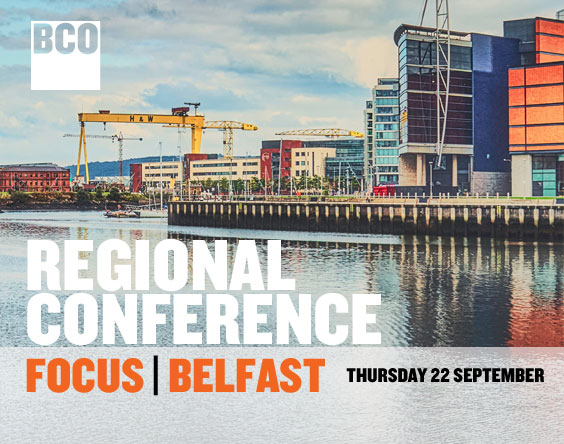
Join us for a One Day Conference on 22 September 2022 in Belfast.
Belfast is a city full of ambition, optimism, and above all, energy. It is a modern, compact capital city packed with history and world-class culture.
As a talented, competitive and connected city, it is the second fastest growing knowledge economy in the UK, with excellent digital infrastructure and thriving clusters of high growth companies in the likes of financial technology and cyber security. It is one of the youngest cities in Europe with over 40 percent of its population aged 30 years or younger and has been recognised as the world’s most business-friendly small city by the FT.
Led by the BCO Northern Committee this one day event will provide the opportunity to understand and engage with the Belfast Office Market and it’s leading occupiers, developers and business leaders.
What to expect?
